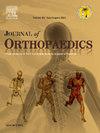A therapeutic assessment of tranexamic acid on functional recovery after rotator cuff repair surgery: A study of early and mid-term follow-up
IF 1.5
Q3 ORTHOPEDICS
引用次数: 0
Abstract
Purpose
To perform therapeutic assessment of tranexamic acid on functional recovery after rotator cuff repair surgery in terms of early and mid-term follow up.
Methods
From December 2021 to April 2023, a total of 40 patients with rotator cuff injury were enrolled and randomly assigned to two groups with equal number of patients, and all patients received shoulder arthroscopic surgery before receiving either tranexamic acid or normal saline managements. Patients in the experimental group, group A, treated with 2g tranexamic acid (diluted with normal saline to 20ml) via intra-articular injection, while patients in the control group (group B) received 20ml normal saline management. The whole process was conducted in accordance with randomized double-blind controlled trials. Clinical outcomes were assessed preoperatively and postoperatively via American Shoulder and Elbow Surgeons (ASES) score, a UCLA shoulder rating, a CONSTANT score, and visual analog scale (VAS). Early and mid-term follow-up were performed at 1 week, 1 month, 3 months, and 6 months after surgery.
Results
The ASES score and CONSTANT score at 1 month, 3 months and 6 months after operation in the tranexamic acid group were higher than those in the normal saline group (p < 0.05). Meanwhile, the UCLA score at 3 months and 6 months after operation in the tranexamic acid group was higher than that in the normal saline group (p < 0.05). In addition, the muscle strength score and external rotation value at 6 months after operation in the tranexamic acid group and normal saline group were higher than those in the normal saline group (p < 0.05). There was no significant difference in the VAS score between the two groups at each observation cut-off point (p > 0.05).
Conclusions
Injection of tranexamic acid after rotator cuff repair surgery plays an positive role on the recovery of patients muscle strength and tone as well as shoulder flexibility. Therapeutic assessment demonstrates the favorable clinic efficacy either early or mid-term follow-up.
氨甲环酸对肩袖修复术后功能恢复的疗效评价:一项早期和中期随访研究
目的从早期和中期随访的角度评价氨甲环酸对肩袖修复术后功能恢复的疗效。方法从2021年12月至2023年4月,共纳入40例肩袖损伤患者,随机分为两组,两组患者人数相同,所有患者均接受肩关节镜手术,然后接受氨甲环酸或生理盐水处理。实验组(A组)给予2g氨甲环酸(用生理盐水稀释至20ml)关节内注射,对照组(B组)给予生理盐水20ml治疗。整个过程按照随机双盲对照试验进行。通过美国肩关节外科医生(American Shoulder and肘外科医生)评分、UCLA肩关节评分、CONSTANT评分和视觉模拟评分(VAS)评估术前和术后的临床结果。分别于术后1周、1个月、3个月、6个月进行早期和中期随访。结果氨甲环酸组术后1个月、3个月和6个月的as评分和CONSTANT评分均高于生理盐水组(p <;0.05)。同时,氨甲环酸组术后3个月和6个月的UCLA评分均高于生理盐水组(p <;0.05)。此外,氨甲环酸组和生理盐水组术后6个月肌力评分和外旋值均高于生理盐水组(p <;0.05)。两组在各观察分界点的VAS评分差异无统计学意义(p >;0.05)。结论肩袖修复术后注射氨甲环酸对患者肌力、张力及肩部柔韧性恢复有积极作用。早期或中期随访均显示临床疗效良好。
本文章由计算机程序翻译,如有差异,请以英文原文为准。
求助全文
约1分钟内获得全文
求助全文
来源期刊

Journal of orthopaedics
ORTHOPEDICS-
CiteScore
3.50
自引率
6.70%
发文量
202
审稿时长
56 days
期刊介绍:
Journal of Orthopaedics aims to be a leading journal in orthopaedics and contribute towards the improvement of quality of orthopedic health care. The journal publishes original research work and review articles related to different aspects of orthopaedics including Arthroplasty, Arthroscopy, Sports Medicine, Trauma, Spine and Spinal deformities, Pediatric orthopaedics, limb reconstruction procedures, hand surgery, and orthopaedic oncology. It also publishes articles on continuing education, health-related information, case reports and letters to the editor. It is requested to note that the journal has an international readership and all submissions should be aimed at specifying something about the setting in which the work was conducted. Authors must also provide any specific reasons for the research and also provide an elaborate description of the results.
 求助内容:
求助内容: 应助结果提醒方式:
应助结果提醒方式:


